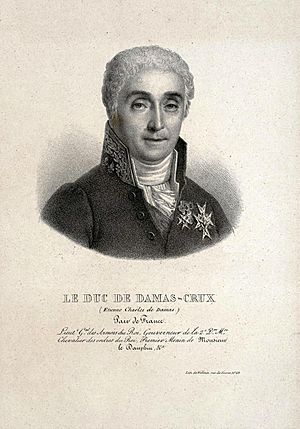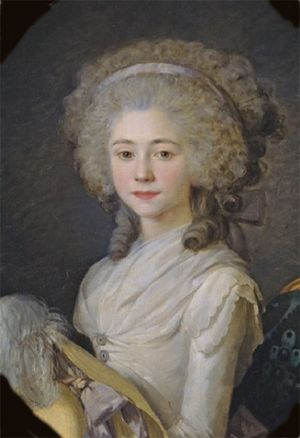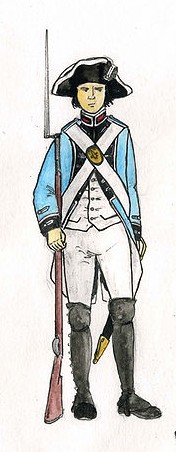Étienne-Charles de Damas-Crux facts for kids
Quick facts for kids
Étienne-Charles de Damas-Crux
KOHS GCOSL
|
|
|---|---|

Portrait engraving of Damas-Crux
|
|
| Born | 10 February 1754 Château de Crux, Nivernais, France |
| Died | 29 May 1846 (aged 92) Paris, France |
| Allegiance | |
| Service/ |
|
| Years of service | 1770–1832 |
| Rank | Lieutenant General |
| Unit | Ancien Régime: Regiment of Limousin (1770–1779) Regiment of Aquitaine (1779–1784) Regiment of Vexin (1784–1791) French Revolutionary Wars: Bourbon Restoration: |
| Battles/wars | |
| Awards | |
Étienne-Charles, Duke of Damas-Crux (born February 10, 1754 – died May 29, 1846) was a French soldier and politician. He came from one of France's oldest noble families, the House of Damas. He was the last son of Louis Alexandre de Damas, Count of Crux.
Étienne-Charles became a high-ranking officer in the king's army. He was also welcomed into the Knights of Malta, a famous religious and military order.
Contents
Early Life and Family
Étienne-Charles was born at the Château de Crux in Nivernais, France. He was the youngest son of Louis Alexandre de Damas, Count of Crux. His mother was Marie-Louise de Menou.
From a young age, he was part of the Order of St. John of Jerusalem. However, he never took the final vows to become a full Knight. This choice later allowed him to get married.
In 1799, he married Anne-Félicité-Simone. She was the daughter of Armand-Louis de Sérent, Duke of Sérent. Her mother, Bonne Marie Félicité de Montmorency-Luxembourg, held important positions in the royal court. She served Princess Élisabeth of France and later Marie Thérèse of France.
Military Adventures
Starting His Military Career
Étienne-Charles de Damas-Crux began his army career on February 22, 1770. He joined the Régiment de Limousin as a second lieutenant. He quickly moved up, becoming a captain in the same regiment by 1772.
Later, in 1779, he became second-in-command of the Régiment d'Aquitaine. With this regiment, he fought in the East Indies during the American Revolutionary War. He also led a unit of sepoy soldiers. One day, his unit panicked and ran away. Damas-Crux bravely stayed on the battlefield almost alone. He was eventually captured.
Soon after his capture, France and Britain made peace. This allowed him to return to France. In 1784, he became a commander, leading the Régiment de Vexin.
Fighting in the French Revolution
When the French Revolution began, Damas-Crux supported the king. He left France, joining other nobles who had also left. Some soldiers from his Vexin regiment even joined him from Monaco. These men fought under his command in 1792.
In 1793, he created his own army unit called the 'Légion de Damas'. He led them in battles in the Netherlands that year. When the French Revolutionary Army invaded the Netherlands, his legion started getting paid by the British.
His unit wanted to land in western France. But this plan went wrong, and many of his soldiers were lost during the Quiberon expedition in July 1795. In 1796, Damas-Crux made a deal with the Prince of Condé. This allowed him to form a small group of cavalry soldiers (hussars) from his remaining legion. He then led this group as part of the Army of Condé.
In 1795, Louis XVIII promoted Damas-Crux to a higher rank. He followed Condé's army to Poland in 1801. The next year, he and Condé joined the Russian army. Damas-Crux also worked for the Duke of Angoulême in Russia. He traveled with him to England.
The Bourbon Restoration
Damas-Crux finally returned to France in March 1814 with the armies that defeated Napoleon. He joined the Duke of Angoulême and helped him in many ways. On August 22, 1814, he was made a knight grand cross of the Order of Saint Louis.
During the Hundred Days (when Napoleon briefly returned to power), Damas-Crux was sent to Toulouse. He was arrested but managed to rejoin the Duke of Angoulême in Madrid. From there, he went to Tolosa and Irun to recruit French Royalists. He entered Bayonne on July 25, escorted by 1,800 Basques he had recruited. He refused help from a Spanish general, preferring to lead his own forces. After Napoleon's final defeat, Damas-Crux became a governor and commander of the Army of the Pyrénées.
On July 17, 1815, he became a peer of France. He voted for the death penalty for Michel Ney, a famous general. For his service during the Napoleonic Wars, he was made a duke on February 3, 1816. He became a knight of the Order of the Holy Spirit in 1824.
He continued to serve in different military divisions. In March 1816, the Duke of Angoulême gave him special missions in the Midi region of France. He completed these tasks.
After the July Revolution, Damas-Crux stayed loyal to the old government. He refused to swear loyalty to the new king, Louis Philippe. Because of this, he left the upper chamber of parliament. He retired from the army as a lieutenant general on June 30, 1832. Étienne-Charles de Damas-Crux died in Paris fourteen years later. He and his wife did not have any children. So, his family line (the Damas-Crux branch) ended with him.



